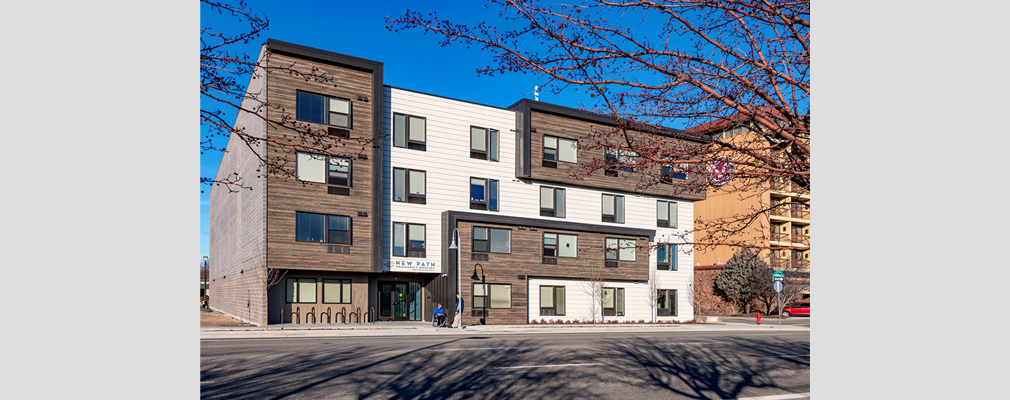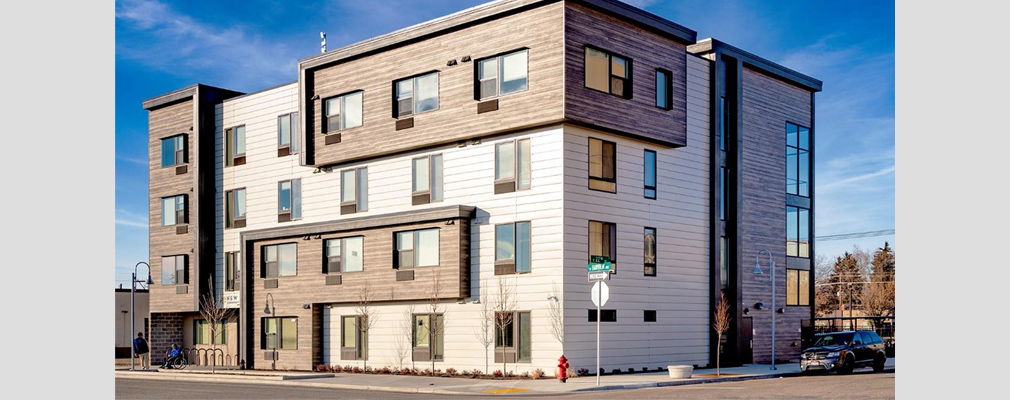Home >Case Studies >Boise, Idaho: Our Path Home Brings the Housing First Model to Idaho
Boise, Idaho: Our Path Home Brings the Housing First Model to Idaho
Ada County, Idaho, reported 833 people experiencing homeless in 2017. By far the most populated county in the state, Ada County is anchored by Boise, the state's capitol. That same year, the city of Boise worked with several public and private partners to create Our Path Home, whose mission is to end homelessness in Ada County. Our Path Home was founded on the principle that permanent supportive housing is the best way to address homelessness. The city began to encourage projects that employ the Housing First model after city leaders toured sites in the western United States that used this model. The city and several of its Our Path Home partners worked with developers Northwest Integrity Housing Company, Pacific West Communities, and Thomas Development Co. to build New Path Community Housing, which opened in 2018. New Path is the state’s first permanent supportive housing project that is open to people experiencing homelessness and does not require a commitment to sobriety. New Path is also notable as being one of Boise’s biggest accomplishments in its efforts to address homelessness since 2009, when, in Martin v. City of Boise, federal courts found that the city’s ordinance fining people for sleeping on public streets unconstitutionally criminalized “sitting, sleeping, or lying outside on public property for homeless individuals who cannot obtain shelter.” The development won a 2020 Charles L. Edson Tax Credit Excellence Award in the Small Metropolitan category from the Affordable Housing Tax Credit Coalition.
Housing First for the Chronically Homeless
The 4-story apartment building contains 40 units for people who have experienced chronic homelessness and their partners. Four of these apartments have one bedroom, and the rest are studios. Residents can relax and socialize in a large community room, exercise in a fitness center and outdoor recreational space, and access a computer center. The property’s location in downtown Boise allows residents to walk or bike to the many nearby businesses and parks as well as the public library. Residents can also easily access several of the city’s bus routes.
New Path residents are chosen through a prioritization process that focuses on their duration of homelessness and frequency of encounters with the emergency medical system or the criminal justice system. During its first year of operation, New Path welcomed 57 residents, including several partners of prioritized residents. Residents, whose rent payments are supported with project-based vouchers from the Boise City/ Ada County Housing Authorities, may stay at New Path indefinitely. After living at New Path for a year, residents who wish to move to other housing are eligible for a tenant-based voucher.
Most residents have chronic or debilitating health conditions such as mental or brain disorders, long-term addictions to drugs or alcohol, or trauma. These residents require weekly — if not daily — care from staff. New Path, through Terry Reilly Health Services, provides vital services to this vulnerable population around the clock. Twelve onsite staff provide case management, physical and mental health care, substance abuse counseling, life skills training, and peer support groups. Other assistance includes helping residents obtain Social Security and other government benefits.
Financing for New Path
Almost all of New Path’s development costs were paid through low-income housing tax credit equity provided by American Express National Bank (table 1). The rest of the project’s $7 million financing came from the Idaho Housing and Finance Association (IHFA) and Boise’s general fund. This package allowed New Path to be developed with no debt financing.
Table 1: New Path Community Housing Financing
| Low-income housing tax credits | $5,830,000 |
| IHFA HOME Investment Partnerships Program | 500,000 |
| City of Boise | 1,000,000 |
| Total | $7,330,000 |
The Saint Alphonsus and Saint Luke’s healthcare systems provide annual grants of $100,000 each for support services. Ada County has also helped finance onsite social services, contributing more than $100,000 in 2020. The county has committed to funding these services until 2022, at which point the city will provide this funding.
Program Evaluation
Following an evidence-based approach, the Idaho Policy Institute evaluates New Path’s Housing First program annually using data from local agencies and resident surveys. The institute has completed two evaluations: one for 2019 and one for 2020. In both reports, the authors analyze New Path’s effect on residents’ interactions with the criminal justice and healthcare systems. The researchers find a sizable decrease in participants’ jail stays, with residents cumulatively spending between 50 and 100 days in jail per month before moving into New Path and fewer than 10 days per month within 4 months of moving into New Path. The researchers note similar reductions in utilization of paramedic services, emergency room care, hospital visits, and substance abuse and mental health services. For example, residents’ cumulative emergency-room stays of 17 days per month before moving to New Path were reduced to only 7 days per month after moving in.
The evaluations also include surveys of residents’ perceived quality of life. After moving to New Path, residents reported reduced levels of depression and improvements in the “meaningfulness” and “enjoyment” of life. Residents also noted that they felt safer, enjoyed better living conditions, and gained a “marked increase” in leisure opportunities. Kendra Lutes, the associate behavioral health director at New Path, and Susie Johnson, the social worker at New Path, concur that this housing and accompanying services have boosted residents’ physical and mental health. Johnson also gives significant credit to a third-party service provider who distributes residents’ monthly Social Security payments in smaller and more frequent intervals. Participating residents have a more manageable stream of income that encourages better budgeting habits.
New Path’s program also has benefited the community financially. The evaluations found that residents spent 1,336 fewer days using “reactive services” during New Path’s first 2 years, a reduction of more than 60 percent that saved the community nearly $2.6 million. Because New Path prioritized the neediest residents, however, the researchers acknowledge that the savings might be reduced for Housing First programs serving a different segment of the chronically homeless population.
The evaluations also identify opportunities to improve the program. Funding sources offering longer-term commitments could ease stress for staff and residents alike. Partners and staff would also welcome increased communication. Nevertheless, the initial data suggest that the Housing First model has worked in Idaho. Based on New Path’s results, Our Path Home has opened the state’s second Housing First project, Valor Pointe, a 27-unit supportive housing development serving veterans who have experienced chronic homelessness.
Anchor Institutions
- U.S. Virgin Islands Nonprofit Helps Community Focus on Disaster Recovery and Resiliency
- A Model for Community-Based Policing in Pittsburgh
- Click here for more
Community Development
- Chattanooga, Tennessee: Multifamily Prototypes for Infill Development to Address Missing Middle Housing
- Scattered-Site Rehabilitation Pilots New RAD Section 18 Blend in Springfield, Missouri
- Click here for more
Senior Housing
- Former School in Charleston, South Carolina, Transformed into Affordable Housing for Seniors
- Richmond, California: Rehabilitation of Vacant Public Housing Site Preserves Senior Housing
- Click here for more
Supportive Housing
- Yakima, Washington: An Adaptive Reuse Project Provides Supportive Housing for Formerly Homeless Veterans
- Village on Mercy Provides Supportive Housing in Orlando, Florida
- Click here for more
Sustainable Housing
- Pacific Landing Provides Energy-Efficient Affordable Housing in Santa Monica, California
- Innovative Solar Technology Powers Affordable Housing in River Falls, Wisconsin
- Click here for more
Zoning for Affordable Housing
The contents of this article are the views of the author(s) and do not necessarily reflect the views or policies of the U.S. Department of Housing and Urban Development or the U.S. Government.



